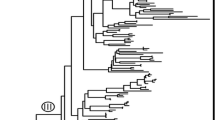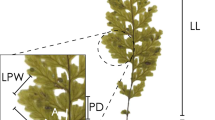Abstract
A phylogenetic analysis of the leafy liverwort genus Mesoptychia (incl. Leiocolea and Hattoriella), using two chloroplast markers, rbcL and rps4, was performed to clarify the circumscription of the genus and to establish its systematic position within the Jungermanniales. Ten species and one variety of Mesoptychia (out of a total of 17 accepted specific names), together with 85 species from 57 genera representing different lineages of Jungermanniales, were sampled. The results support the monophyly of Mesoptychia and its inclusion within the Jungermanniaceae, which itself forms a clade with the Delavayellaceae. Gymnocolea borealis, previously treated under Leiocolea (= Mesoptychia), is nested in the Anastrophyllaceae. The synonymy of Hattoriella with Mesoptychia is phylogenetically confirmed. Four major clades are identified within Mesoptychia and their circumscriptions and distinguishing morphological features are discussed.

Similar content being viewed by others
References
Arnell S (1956) Illustrated moss flora of Fennoscandia. I Hepaticae, Botanical Society, Lund
Cox CJ, Goffinet B, Newton AE, Shaw AJ, Hedderson TAJ (2000) Phylogenetic relationships among the diplolepideous-alternate mosses (Bryidae) inferred from nuclear and chloroplast DNA sequences. Bryologist 103:224–241
Crandall-Stotler B, Stotler RE, Long DG (2008) Morphology and classification of the Marchantiophyta. In: Goffinet B, Shaw AJ (eds) Bryophyte biology, 2nd edn. Cambridge University Press, Cambridge, pp 1–54
Crandall-Stotler B, Stotler RE, Long DG (2009) Phylogeny and classification of the Marchantiophyta. Edinb J Bot 66(1):155–198
Damsholt K (2002) Illustrated flora of nordic liverworts and hornworts. Nordic Bryological Society, Lund
Davis EC (2004) A molecular phylogeny of leafy liverworts (Jungermanniidae: Marchantiophyta). In: Goffinet B, Hollowell V, Magill R (eds) Molecular systematics of Bryophytes. Missouri Botanical Garden Press, St. Louis, pp 205–231
De Roo RT, Hedderson TA, Söderström L (2007) Molecular insights into the phylogeny of the leafy liverwort family Lophoziaceae Cavers. Taxon 56(2):301–314
Doyle JJ, Doyle JL (1987) A rapid DNA isolation procedure for small quantities of fresh leaf tissue. Phytochem Bull 19:11–15
Edgar RC (2004) MUSCLE: multiple sequence alignment with high accuracy and high throughput. Nucleic Acids Res 32(5):1792–1797
Forrest LL, Davis EC, Long DG, Crandall-Stotler BJ, Clark A, Hollingsworth ML (2006) Unraveling the evolutionary history of the liverworts (Marchantiophyta): multiple taxa, genomes and analyses. Bryologist 109(3):303–334
Frey W, Frahm JP, Fischer E, Lobin W (2006) The liverworts. Harley Books, Essex, Mosses and Ferns of Europe
Heinrichs J, Gradstein SR, Wilson R, Schneider H (2005) Towards a natural classification of liverworts (Marchantiophyta) based on the chloroplast gene rbcL. Cryptogam Bryol 26(2):131–150
Heinrichs J, Hentschel J, Wilson R, Feldberg K, Schneider H (2007) Evolution of leafy liverworts (Jungermanniidae, Marchantiophyta): estimating divergence time from chloroplast DNA sequences using penalized likelihood with integrated fossil evidence. Taxon 56(1):31–44
Hentschel J, Paton JA, Schneider H, Heinrichs J (2007) Acceptance of Licholaena Nees and Solenstoma Mitt, the systematic position of Eremonotus Pearson and notes on Jungermannia L. sl. (Jungermanniidae) based on chloroplast sequence data. Plant Syst Evol 268:147–157
He-Nygrén X, Juslén A, Ahonen I, Glenny D, Piippo S (2006) Illuminating the evolutionary history of liverworts (Marchantiophyta)-towards a natural classification. Cladistics 22:1–31
Hollingsworth ML, Clark AA, Forrest LL, Richardson J, Pennington RT, Long DG, Cowan R, Chase MW, Gaudeul M, Hollingsworth PM (2009) Selecting barcoding loci for plants: evaluation of seven candidate loci with species-level sampling in three divergent groups of land plants. Mol Ecol Res 9(2):439–457
Kress WJ, Erickson DL (2007) A two-locus global DNA barcode for land plants: the coding rbcL gene complements the non-coding trnH-psbA spacer region. PLoS ONE 2(6):e508
Maddison DR, Maddison WP (2005) MacClade 4: analysis of phylogeny and character evolution. Version 408a. Sinauer Associates, Sunderland
Nadot S, Bajon R, Lejeune B (1994) The chloroplast gene rps4 as a tool for the study of Poaceae phylogeny. Plant Syst Evol 191(1–2):27–38
Nebel M, Philippi G (2005) Die moose baden-württembergs, vol 3. Verlag Eugen Ulmer, Stuttgart
Paton JA (1999) The liverwort flora of the British isles. Harley Books, Essex
Paton JA, Perry R (1995) Leiocolea fitzgeraldiae sp. nov. in Britain and Ireland. J Bryol 18:469–478
Ronquist F, Teslenko M, van der Mark P, Ayres DL, Darling A, Höhna S, Larget B, Liu L, Suchard MA, Huelsenbeck JP (2012) MrBayes 32: efficient bayesian phylogenetic inference and model choice across a large model space. Syst Biol 61(3):539–542
Schuster RM (1986) Gymnocolea borealis (Frisvoll et Moen) Schust. [Lophozia (Leiocolea) borealis Frisvoll et Moen] in North America. Lindbergia 12:5–8
Smith AJE (1990) The liverworts of Britain and Ireland. Cambridge University Press, Cambridge
Söderström L (1981) Norrlands bladlevermossor (Leafy hepatics of Northern Sweden). Fältbiologerna, Sollentuna
Swofford DL (2002) PAUP* Phylogenetic analysis using parsimony (*and other methods). Version 4. Sinauer Associates, Sunderland
Váňa J, Hubáčková J (1989) Lophozia bantriensis (Hook.) Steph. and L. collaris (Nees) Dum.—conspecific or separate species? In: Herben T, McQueen CB (eds) Proceedings of the sixth meeting of the Central and East European bryological working group (CEBWG), Liblice, Czechoslovakia, 12th–16th September 1988, Průhonice, pp 217–228
Váňa J, Söderström L, Hagborg A, Von Konrat M (2012) Notes on early land plants today. 8. New combinations and some lectotypifications in Mesoptychia. Phytotaxa 65:52–56
Vilnet AA, Konstantinova NA, Troitsky AV (2010) Molecular insight on phylogeny and systematics of the Lophoziaceae, Scapaniaceae, Gymnomitriaceae and Jungermanniaceae. Arctoa 19:31–50
Vilnet AA, Konstantinova NA, Troitsky AV (2011) Taxonomical rearrangements of Solenostomataceae (Marchantiophyta) with description of a new family Endogemmataceae based on trnL-F cpDNA analysis. Folia Cryptogam Est 48:125–133
Yatsentyuk SP, Konstantinova NA, Ignatov MS, Hyvönen J, Troitsky AV (2004) On the phylogeny of Lophoziaceae and related families (Hepaticae, Jungermanniales) based on trnL-trnF intronspacer sequences of chloroplast DNA. In: Goffinet B, Hollowell V, Magill R (eds) Molecular systematics of Bryophytes. Missouri Botanical Garden Press, St. Louis, pp 150–165
Acknowledgments
The first author would like to thank SYNTHESYS for financing her visit to the Royal Botanic Garden Edinburgh, UK (RBGE), RBGE and its staff for their collaboration and supply of specimens, the Conservatoire et Jardin botaniques de la Ville de Genève, Switzerland (CJBG) for the laboratory facilities, the staff of the CJBG laboratory for their assistance, Dr. Yamama Naciri (CJBG) for her advice and support, the Association des Amis du Jardin Botanique for financing field trips in the Swiss Alps, the Bourse Augustin Lombard for financing field work in Sweden, the Abisko Scientific Research Station for funding a research visit, Dr. Higuchi (TNS) and Dr. Risto Virtanen (OULU) for specimens, and Drs. Nadir Alvarez (University of Lausanne, Switzerland), Louis Nusbaumer (CJBG) and Camille Truong (CJBG) for their advice and discussions. We thank the two anonymous reviewers for their critical comments.
Author information
Authors and Affiliations
Corresponding author
Rights and permissions
About this article
Cite this article
Cailliau, A., Long, D.G., Price, M.J. et al. Phylogeny and systematic position of Mesoptychia (Lindb.) A. Evans. Plant Syst Evol 299, 1243–1251 (2013). https://doi.org/10.1007/s00606-013-0792-z
Received:
Accepted:
Published:
Issue Date:
DOI: https://doi.org/10.1007/s00606-013-0792-z




